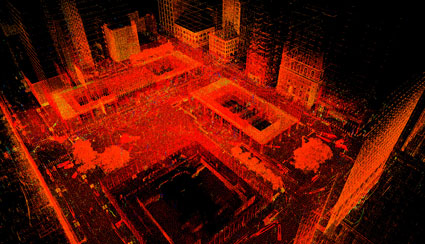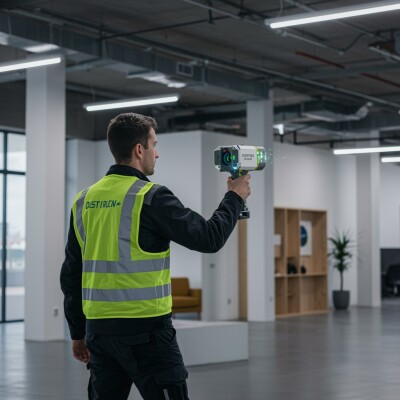Project Background
Under an IDIQ contract with the US General Services Administration’s Great Lakes Region, Ghafari was selected to design the restoration of the Chicago Federal Center (CFC) Plaza. The Federal Center was designed by Mies van der Rohe in the 1960s and is home to Alexander Calder’s steel sculpture, “The Flamingo”.
Principal buildings at the CFC include the 43 story, 1.2 million sq. ft., John C. Kluczynski Federal Building and Loop Station Post Office as well as the 30 story, 1.4 million sq. ft. Everett McKinley Dirksen US Courthouse and several other buildings.
At the plaza level, the restoration of the plaza deck / roof requires the removal of the existing waterproofing system and the installation of a new system with improved thermal insulating properties to increase energy efficiency. This process also requires the removal and reinstallation of approximately 130,000 sq. ft. of granite pavers and a new plaza drainage system. The plaza level work also includes the restoration of various plaza components, such as the Calder sculpture, vehicle ramps, benches, landscaped planters, security bollards, handicapped curb ramps and associated multi-discipline work at the sub-plaza levels.
In 2009, Ghafari was awarded a GSA IDIQ contract to provide BIM and laser scanning consulting services for projects that are to be BIM enabled. With Ghafari’s selection as both the A/E and BIM provider for the plaza restoration, the team had the opportunity to explore new laser scan to model workflows and technologies in support of the plaza restoration’s design and construction.
Field Collection
Ghafari’s laser scanning teams used an in-house Leica 6000 phase-based scanner to collect more than 500 scans of the plaza. This work was carried out by teams of two over a 30 day period. Scanning was done at night to prevent interruption of normal work activity as well as to eliminate as much pedestrian “noise” from the scan data as possible. The data collected from these scans served as the basis for Ghafari’s generation of Revit models and drawings required under the contract to support design and build-side requirements.
Point Cloud Processing and Revit Modeling
Due to the project’s compressed schedule, Ghafari’s design team began creating the Revit model in parallel with the scanning effort using existing 2D drawings of the plaza and sub-levels. The drawings from the 1960s provided a starting point that could be updated by the scan data. As scan data came in from the field, it was registered using Leica Cyclone. EdgeWiseTM by ClearEdge3D was then used to “automatically” extract rectilinear polygons from the point clouds. These polygons were imported into Revit, skipping the manual modeling step – traditionally one of the most time-consuming processes associated with scan-to-Revit modeling. Manual modeling practices typically required the scan team to create a first pass model that was essentially traced over by the design team in Revit. This non-integrated workflow resulted in several inefficiencies:
1) Scan teams are engaged before the design team has set objectives, therefore scan team models may be over or under-modeled due to their unfamiliarity with design team expectations.
2) Models created by scan teams, separate from the design team users, are forced to incorporate numerous assumptions and interpretations.
3) Scan team models are often delivered as one collective batch, sometimes delaying the start of design team modeling until the scan model is available, and almost always missing the opportunity for soliciting design team feedback to fine tune scanning areas of interest.
4) Unless the model data is round-tripped against the original point cloud data sets, it is probable that there will be discrepancies between the scan teams’ model interpretation and the design teams’ model interpretation.
Improved Workflows
Because Ghafari was providing both the laser scanning and A/E services for the CFC project, it provided an opportunity to improve upon past manual modeling practices. These improvements came from both lean inspired work and data flows, and from utilizing newer technologies, such as EdgeWise.
- Lean: Models created by scan teams unfamiliar with the A/Es downstream scope of work can lead to several inefficiencies stemming from large batch flow, over or under modeling, and limited feed back from the A/E end-user that might improve scan team data capture/modeling approaches. Exhibit A (above) graphically compares the improved small-batch workflow enabled by EdgeWise and NavisWorks used on the CFC project (A.1) with the large-batch processing of 3-4 years ago (A.2).
- Combining the small batch flow with EdgeWise allowed “automatically” generated polygons to be imported into Revit, largely by-passing the inefficiencies associated with the intermediate scan-to-model step. Scripting was used to move the EdgeWise (.C3S) polygons via .dwg and .ifc into Revit, and the design team could then adjust (“nudge”) their existing models (from the 2D plans) or build new features directly on top of the EdgeWise polygons.
- This improved workflow allowed the design team to model only what was needed – when it was needed to support milestone delivery dates. Without EdgeWise, the scan team would have had to manually model the observed surfaces in the point cloud (using software that could be imported into Revit since point clouds cannot be imported directly), take the results into Revit, and model it again to create the Revit data.
- Round-Tripping: The last step in the design team’s workflow was to bring both the Revit model data set and original point cloud into NavisWorks to validate that models reasonably matched the existing conditions captured in the point cloud.
Conclusion
The GSA has been encouraging their design/construction partners to adopt laser scanning and BIM best practices to improve project delivery results, and has authored best practice guides for spatial validation, laser scanning, BIM, 3D/4D and energy performance. In late 2009, the GSA selected multiple firms, under a five year IDIQ, to assist in the deployment of those best practices.
As an integrated A/E that has scanned more than 15 million sq. ft. since 2001, Ghafari understood the opportunity for improving industry scan-to-model processes. Giving the design team the tools and techniques to do its own modeling and modeling only what was needed when it was needed represented a significant improvement in scan to Revit modeling efficiencies for the Chicago Federal Center Plaza Restoration Project.
These improved workflows were presented at SPAR in February 2010 and recapped in this article in support of the GSA’s objectives for continuously improving building industry best practices.
GSA BIM & Laser Scanning Profile
During 2009, the GSA laser scanned 25 buildings nationally and adopted BIM on 64 projects with 18 million sq. ft. modeled. Many of those best practices have been summarized in the GSA BIM Guide for 3D Imaging, Series 03. In 2009 Region 5, The Great Lakes Region, laser scanned 10 buildings, adopted BIM on 10 projects and modeled 8 million sq. ft.
Ghafari Company Profile
Ghafari Associates, LLC (www.ghafari.com) is a full-service architecture, engineering and consulting firm with diverse experience and offices around the world. Ghafari is recognized as an industry leader in applying 3D BIM, laser scanning and Integrated Project Delivery (IPD) principles across the design / fabrication / construction value stream, helping clients achieve breakthrough project results.
All images courtesy of the GSA






